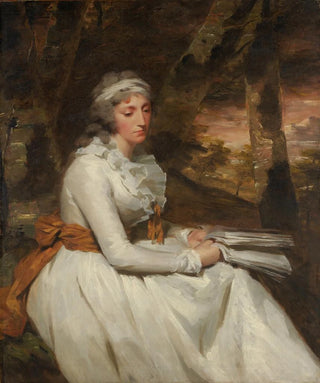Art print | Mme Richard Alexander Oswald - Sir Henry Raeburn


View from behind

Frame (optional)
Sir Henry Raeburn's "Mme Richard Alexander Oswald" is a work that transcends a simple portrait to offer a window into the human soul. Created in the early 19th century, it captures not only the physical appearance of its subject but also an essence, a vibrant personality that seems to defy time. This painting, emblematic of the neoclassical style, demonstrates technical mastery and artistic sensitivity that continue to fascinate art enthusiasts. By contemplating this art print, the viewer is invited to immerse themselves in the delicate and refined universe of the era, while pondering the life and aspirations of the woman depicted.
Style and uniqueness of the work
Raeburn's style in this piece is characterized by a subtle use of light and shadow, which confers a striking depth to Mme Oswald's face. The chosen colors, both soft and contrasted, highlight the texture of the clothing and the smoothness of the skin. Every detail is treated with remarkable precision, from the delicacy of the hands to the elegance of the drapery. The woman's posture, slightly tilted, evokes intimacy, a closeness that invites the viewer to come closer. Raeburn manages to capture a fleeting moment, an expression that appears both serene and full of thoughts. This blend of simplicity and sophistication gives the work a singularity that sets it apart from contemporary portraits, where realism could sometimes give way to exaggerated features.
The artist and his influence
Sir Henry Raeburn, an iconic figure of Scottish painting, knew how to mark his era with his innovative approach to portraiture. Born in 1756, he evolved in an artistic context where neoclassicism was flourishing. Raeburn combined this influence with a personal sensitivity, creating works that speak to the soul. His talent lies in his ability to reveal the personality of his subjects, making them lively and accessible to the viewer. His technique, which combines mastery of colors and an intuitive understanding of light, has inspired many artists, both of his time and subsequent generations.

Matte finish

View from behind

Frame (optional)
Sir Henry Raeburn's "Mme Richard Alexander Oswald" is a work that transcends a simple portrait to offer a window into the human soul. Created in the early 19th century, it captures not only the physical appearance of its subject but also an essence, a vibrant personality that seems to defy time. This painting, emblematic of the neoclassical style, demonstrates technical mastery and artistic sensitivity that continue to fascinate art enthusiasts. By contemplating this art print, the viewer is invited to immerse themselves in the delicate and refined universe of the era, while pondering the life and aspirations of the woman depicted.
Style and uniqueness of the work
Raeburn's style in this piece is characterized by a subtle use of light and shadow, which confers a striking depth to Mme Oswald's face. The chosen colors, both soft and contrasted, highlight the texture of the clothing and the smoothness of the skin. Every detail is treated with remarkable precision, from the delicacy of the hands to the elegance of the drapery. The woman's posture, slightly tilted, evokes intimacy, a closeness that invites the viewer to come closer. Raeburn manages to capture a fleeting moment, an expression that appears both serene and full of thoughts. This blend of simplicity and sophistication gives the work a singularity that sets it apart from contemporary portraits, where realism could sometimes give way to exaggerated features.
The artist and his influence
Sir Henry Raeburn, an iconic figure of Scottish painting, knew how to mark his era with his innovative approach to portraiture. Born in 1756, he evolved in an artistic context where neoclassicism was flourishing. Raeburn combined this influence with a personal sensitivity, creating works that speak to the soul. His talent lies in his ability to reveal the personality of his subjects, making them lively and accessible to the viewer. His technique, which combines mastery of colors and an intuitive understanding of light, has inspired many artists, both of his time and subsequent generations.






